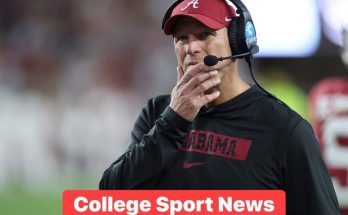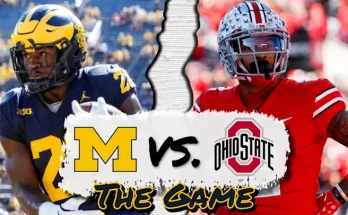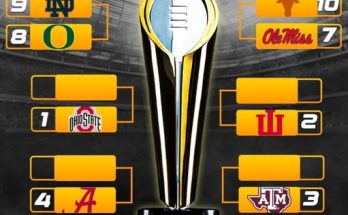The Oklahoma Sooners Just Missed Out on What the Football Program Had Always Considered a Pipe Dream
The Oklahoma Sooners football program has long been one of the most storied and prestigious programs in the history of college football. With a rich tradition of success that spans decades, the Sooners have built a reputation that resonates not just in the Big 12 but across the entire college football landscape. From legendary coaches like Bud Wilkinson and Barry Switzer to iconic players like Adrian Peterson and Baker Mayfield, Oklahoma has a history of producing top-tier talent and consistently competing for national championships.
For decades, one goal has lingered in the minds of fans, players, and coaches alike—a goal so lofty it was once considered nothing more than a pipe dream. That goal was simple: to become the first team in college football history to win back-to-back national championships in the playoff era. The Sooners had come close on several occasions, but each time, they fell just short. Until one season, it seemed like it might finally happen.
The Dream
Oklahoma’s football program has always been known for its high-powered offense, but one of the consistent critiques of the team in the playoff era was its defense. While the offense could light up the scoreboard, the defense often struggled to match the intensity of the program’s championship aspirations. This imbalance was often the reason the Sooners couldn’t capitalize on their offensive firepower and take the ultimate step toward championship glory.
The goal of back-to-back national titles had been set by many in the program’s upper echelons, but the pursuit of that dream remained elusive. For years, Oklahoma had been a regular fixture in the College Football Playoff (CFP), but each time they fell in the semifinals or final games, leaving fans and pundits alike to wonder if it was simply a pipe dream.
Despite the hurdles, the Oklahoma Sooners football program never wavered. They reloaded each season with talented recruits and continued to innovate offensively. The program’s culture remained focused on winning championships, even if it sometimes felt like they were reaching for something just out of their grasp. Oklahoma fans, ever hopeful, believed that their team was on the verge of greatness, constantly waiting for the year when the pieces would fall into place, and the program could achieve the ultimate feat of back-to-back titles.
2023: A Year of Promise
The 2023 season was shaping up to be the year. After years of consistent playoff appearances, the Sooners had the talent, the coaching staff, and the momentum to make a serious run at the elusive back-to-back national championships. Head coach Brent Venables, who took over the program in 2022, had begun to implement his defensive strategies. Venables, a former defensive coordinator at Clemson, brought a sense of discipline and structure to a unit that had been lacking in previous years. His aggressive, physical style of play seemed to be just what the defense needed to complement the high-octane offense that had been the program’s hallmark for years.
The offense, under the leadership of offensive coordinator Jeff Lebby, was as explosive as ever. Quarterback Dillon Gabriel, a seasoned veteran, had the poise and leadership ability to guide the team to a potential national championship. Gabriel, who had transferred to Oklahoma from UCF, had already shown flashes of brilliance in his first year with the team, and 2023 was expected to be his breakout year. The Sooners also had a stable of talented running backs, wide receivers, and tight ends, all of whom could contribute to the offense in different ways.
Oklahoma’s defense, led by players like defensive end Ethan Downs and linebacker Danny Stutsman, had begun to show marked improvement. The Sooners were no longer seen as a one-dimensional team relying solely on their offensive prowess. Instead, they had become a more complete team with a defense that could stop opposing offenses when needed.
Everything seemed aligned for a deep run in the CFP. After a dominant regular season, which included an undefeated record in the Big 12, Oklahoma entered the CFP as the No. 2 seed, with a legitimate shot at making history and capturing the first-ever back-to-back titles in the playoff era. Fans and analysts alike began to whisper the words: “This could be the year.”
The Road to Glory
Oklahoma’s journey to the CFP was anything but easy. They faced tough competition in the Big 12, including a fierce rivalry matchup against Texas in the Red River Showdown. The Longhorns had become a formidable opponent under their new head coach, Steve Sarkisian, and Oklahoma’s dominance in the conference had been challenged in recent seasons. But the Sooners rose to the occasion, with Gabriel and the offense showcasing their firepower and the defense stepping up when it mattered most.
In the regular season, Oklahoma defeated Texas in a thrilling game that went down to the wire. The victory propelled them into the CFP, where they would face an equally formidable opponent in the semifinal.
The Sooners’ semifinal matchup was against the Georgia Bulldogs, the defending national champions. Georgia, led by head coach Kirby Smart, had been the standard-bearer for excellence in college football. Their defense was feared by teams across the country, and their offense had become more dynamic with the development of quarterback Carson Beck. It was a matchup between two of the most elite programs in the country, and everyone knew that whoever emerged from this game would have to face the challenge of winning it all in the final.
In the first half, it was a back-and-forth battle. The Sooners’ offense was clicking, with Gabriel leading the charge and making timely throws to his playmakers. However, the Georgia defense was every bit as strong as advertised, and they were able to stymie Oklahoma’s offense at key moments. In contrast, Georgia’s offense was efficient, and Beck was making accurate throws, keeping the Sooners’ defense on their heels. The first half ended with Georgia leading by just a few points, but it was clear that this would be a game of inches.
The second half saw Oklahoma’s defense step up in a way they hadn’t all season. The defensive line was putting pressure on Beck, and the secondary was able to limit the big plays that had so often plagued them in years past. For a while, it seemed like the Sooners might have a chance to pull off an upset.
However, in the final minutes, it became evident that Georgia’s depth and experience would prevail. The Bulldogs made a late push, scoring a touchdown in the final moments of the game, sealing the win. Oklahoma’s valiant effort came up short, and the dream of back-to-back national championships was dashed.
The Aftermath: A Bitter Pill to Swallow
The loss to Georgia in the semifinal was a devastating blow for the Sooners, who had invested so much into the belief that this would be their year. While they had made great strides, both offensively and defensively, the game revealed just how much more they still had to work on. The Sooners were good, but they were not yet great enough to defeat a program like Georgia.
For players like Dillon Gabriel, it was a heartbreaking end to what had been an extraordinary season. Gabriel had given everything he had, playing with heart and determination. But despite his best efforts, the Sooners had come up just short.
The loss also raised questions about the team’s future. Would this be the last shot for some of the key players on the roster? How long would it take to reload and be in a position to challenge for another national title? While the Sooners were undoubtedly one of the top programs in the country, the sting of failure was palpable. The pipe dream that had once seemed so attainable had slipped through their fingers.
A Glimpse of Hope
Despite the crushing defeat, there was a sense of optimism for the future of Oklahoma football. The 2023 season had shown that the program was capable of competing at the highest level once again. With the talent they had on both sides of the ball, the Sooners were positioned to make another run at the title in the coming years.
Venables had shown that he could build a defense capable of competing with the best, and Gabriel had proven himself to be one of the top quarterbacks in the nation. The Sooners’ recruiting efforts were strong, with a new class of players coming in that could help the team reload and retool for another championship run.
For Oklahoma, the dream of back-to-back titles might have been a pipe dream for now, but it was far from an impossible one. The Sooners would return, hungry for redemption, and ready to once again chase the ultimate prize.
Conclusion
The 2023 season was a reminder of the fine line between success and failure in college football. For the Oklahoma Sooners, the dream of winning back-to-back national championships was tantalizingly close. They had the pieces in place, but in the end, they just came up short. It was a bitter pill to swallow for a program with such high expectations.
But in the grand scheme of things, the Sooners’ near-miss in 2023 only highlighted their continued excellence. Oklahoma had proved that they were still a force to be reckoned with, and with their eyes fixed on the future, the dream of back-to-back championships could still become a reality. The Sooners would continue to chase that elusive title, knowing that greatness was within their grasp—if only they could reach out and take it.



